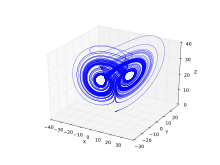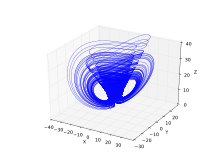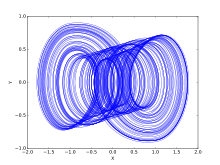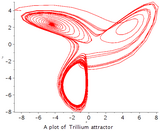Multiscroll attractor

In the mathematics of dynamical systems, the double-scroll attractor (sometimes known as Chua's attractor) is a strange attractor observed from a physical electronic chaotic circuit (generally, Chua's circuit) with a single nonlinear resistor (see Chua's diode). The double-scroll system is often described by a system of three nonlinear ordinary differential equations and a 3-segment piecewise-linear equation (see Chua's equations). This makes the system easily simulated numerically and easily manifested physically due to Chua's circuits' simple design.
Using a Chua's circuit, this shape is viewed on an oscilloscope using the X, Y, and Z output signals of the circuit. This chaotic attractor is known as the double scroll because of its shape in three-dimensional space, which is similar to two saturn-like rings connected by swirling lines.
The attractor was first observed in simulations, then realized physically after Leon Chua invented the autonomous chaotic circuit which became known as Chua's circuit.[1] The double-scroll attractor from the Chua circuit was rigorously proven to be chaotic[2] through a number of Poincaré return maps of the attractor explicitly derived by way of compositions of the eigenvectors of the 3-dimensional state space.[3]
Numerical analysis of the double-scroll attractor has shown that its geometrical structure is made up of an infinite number of fractal-like layers. Each cross section appears to be a fractal at all scales.[4] Recently, there has also been reported the discovery of hidden attractors within the double scroll.[5]
In 1999 Guanrong Chen (陈关荣) and Ueta proposed another double scroll chaotic attractor, called the Chen system or Chen attractor.[6][7]
Chen attractor
The Chen system is defined as follows[7]
Plots of Chen attractor can be obtained with the Runge-Kutta method:[8]
parameters: a = 40, c = 28, b = 3
initial conditions: x(0) = -0.1, y(0) = 0.5, z(0) = -0.6
Other attractors
Multiscroll attractors also called n-scroll attractor include the Lu Chen attractor, the modified Chen chaotic attractor, PWL Duffing attractor, Rabinovich Fabrikant attractor, modified Chua chaotic attractor, that is, multiple scrolls in a single attractor.[9]
Lu Chen attractor

An extended Chen system with multiscroll was proposed by Jinhu Lu (吕金虎) and Guanrong Chen[9]
Lu Chen system equation
parameters:a = 36, c = 20, b = 3, u = -15.15
initial conditions:x(0) = .1, y(0) = .3, z(0) = -.6
Modified Lu Chen attractor

System equations:[9]
In which
params := a = 35, c = 28, b = 3, d0 = 1, d1 = 1, d2 = -20..20, tau = .2
initv := x(0) = 1, y(0) = 1, z(0) = 14
Modified Chua chaotic attractor

In 2001, Tang et al. proposed a modified Chua chaotic system[10]
In which
params := alpha = 10.82, beta = 14.286, a = 1.3, b = .11, c = 7, d = 0
initv := x(0) = 1, y(0) = 1, z(0) = 0
PWL Duffing chaotic attractor

Aziz Alaoui investigated PWL Duffing equation in 2000:[11]
PWL Duffing system:
params := e = .25, gamma = .14+(1/20)i, m0 = -0.845e-1, m1 = .66, omega = 1; c := (.14+(1/20)i),i=-25...25;
initv := x(0) = 0, y(0) = 0;
Modified Lorenz chaotic system

Miranda & Stone proposed a modified Lorenz system:[12]
parameters: a = 10, b = 8/3, c = 137/5;
initial conditions: x(0) = -8, y(0) = 4, z(0) = 10
Gallery
-
 Chen attractor
Chen attractor -
 parameters a = 35, c = 27, b = 2.8,x(0) = -.1, y(0) = .3, z(0) = -.6
parameters a = 35, c = 27, b = 2.8,x(0) = -.1, y(0) = .3, z(0) = -.6 -
 Lu Chen attractor
Lu Chen attractor -
 Maple plot of N scroll attractor based on Chen with sine and tau
Maple plot of N scroll attractor based on Chen with sine and tau -
 9 scroll modified Chua chaotic attractor
9 scroll modified Chua chaotic attractor -
 xy plot of 9 scroll modified Chua chaotic attractor
xy plot of 9 scroll modified Chua chaotic attractor -
 PWL Duffing chaotic attractor xy plot
PWL Duffing chaotic attractor xy plot -
 PWL Duffing chaotic attractor plot
PWL Duffing chaotic attractor plot -
 modified Lorenz attractor
modified Lorenz attractor -
 Rabinovich Fabrikant attractor xy plot
Rabinovich Fabrikant attractor xy plot
References
- ^ Matsumoto, Takashi (December 1984). "A Chaotic Attractor from Chua's Circuit" (PDF). IEEE Transactions on Circuits and Systems. CAS-31 (12). IEEE: 1055–1058. doi:10.1109/TCS.1984.1085459.
- ^ Chua, Leon; Motomasa Komoru; Takashi Matsumoto (November 1986). "The Double-Scroll Family" (PDF). IEEE Transactions on Circuits and Systems. CAS-33 (11).
- ^ Chua, Leon (2007). "Chua circuits". Scholarpedia. 2 (10): 1488. Bibcode:2007SchpJ...2.1488C. doi:10.4249/scholarpedia.1488.
- ^ Chua, Leon (2007). "Fractal Geometry of the Double-Scroll Attractor". Scholarpedia. 2 (10): 1488. Bibcode:2007SchpJ...2.1488C. doi:10.4249/scholarpedia.1488.
- ^ Leonov G.A.; Vagaitsev V.I.; Kuznetsov N.V. (2011). "Localization of hidden Chua's attractors" (PDF). Physics Letters A. 375 (23): 2230–2233. Bibcode:2011PhLA..375.2230L. doi:10.1016/j.physleta.2011.04.037.
- ^ Chen G., Ueta T. Yet another chaotic attractor. Journal of Bifurcation and Chaos, 1999 9:1465.
- ^ a b CHEN, GUANRONG; UETA, TETSUSHI (July 1999). "Yet Another Chaotic Attractor". International Journal of Bifurcation and Chaos. 09 (7): 1465–1466. Bibcode:1999IJBC....9.1465C. doi:10.1142/s0218127499001024. ISSN 0218-1274.
- ^ 阎振亚著 《复杂非线性波的构造性理论及其应用》第17页 SCIENCEP 2007年
- ^ a b c Chen, Guanrong; Jinhu Lu (2006). "Generating Multiscroll Chaotic Attractors: Theories, Methods and Applications" (PDF). International Journal of Bifurcation and Chaos. 16 (4): 775–858. Bibcode:2006IJBC...16..775L. doi:10.1142/s0218127406015179. Retrieved 2012-02-16.
- ^ Chen, Guanrong; Jinhu Lu (2006). "Generating Multiscroll Chaotic Attractors: Theories, Methods and Applications" (PDF). International Journal of Bifurcation and Chaos. 16 (4): 793–794. Bibcode:2006IJBC...16..775L. CiteSeerX 10.1.1.927.4478. doi:10.1142/s0218127406015179. Retrieved 2012-02-16.
- ^ J. Lu, G. Chen p. 837
- ^ J.Liu and G Chen p834
External links
- The double-scroll attractor and Chua's circuit
- Lozi, R.; Pchelintsev, A.N. (2015). "A new reliable numerical method for computing chaotic solutions of dynamical systems: the Chen attractor case". International Journal of Bifurcation and Chaos. 25 (13): 1550187–1550412. Bibcode:2015IJBC...2550187L. doi:10.1142/S0218127415501874. S2CID 12339358.
- v
- t
- e


branches
maps (list)
systems
theorists
- Michael Berry
- Rufus Bowen
- Mary Cartwright
- Chen Guanrong
- Leon O. Chua
- Mitchell Feigenbaum
- Peter Grassberger
- Celso Grebogi
- Martin Gutzwiller
- Brosl Hasslacher
- Michel Hénon
- Svetlana Jitomirskaya
- Bryna Kra
- Edward Norton Lorenz
- Aleksandr Lyapunov
- Benoît Mandelbrot
- Hee Oh
- Edward Ott
- Henri Poincaré
- Itamar Procaccia
- Mary Rees
- Otto Rössler
- David Ruelle
- Caroline Series
- Yakov Sinai
- Oleksandr Mykolayovych Sharkovsky
- Nina Snaith
- Floris Takens
- Audrey Terras
- Mary Tsingou
- Marcelo Viana
- Amie Wilkinson
- James A. Yorke
- Lai-Sang Young
articles







































